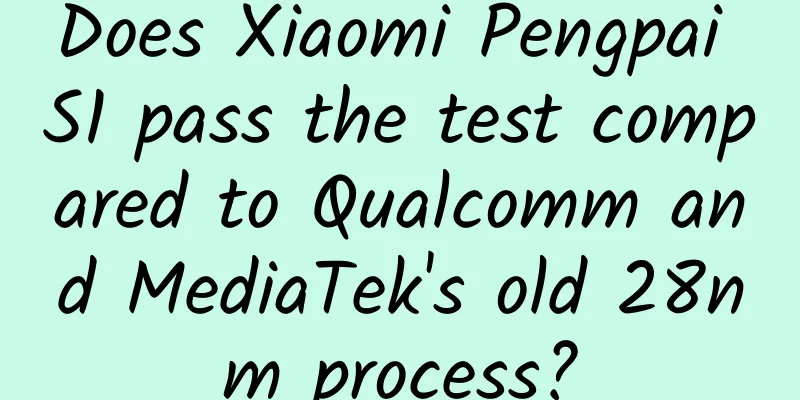Does Xiaomi Pengpai S1 pass the test compared to Qualcomm and MediaTek's old 28nm process?

|
A few days ago, Xiaomi, a Chinese mobile phone manufacturer, released its first self-developed processor: Surge S1. For Xiaomi, it is a 28-month journey of faith. For the industry, Xiaomi is now another mobile processor manufacturer after Qualcomm, MediaTek, Samsung, Huawei HiSilicon and Apple. Xiaomi hopes to become a great company by mastering new technologies. In any case, for us, the more mobile chip manufacturers, the better, after all, it is a blessing for consumers. Xiaomi was once the No. 1 smartphone manufacturer in China, but its market share has now fallen to fourth place, and it is also facing difficulties in overseas markets. Lei Jun, the CEO of Xiaomi, believes that "this is related to the second half of the mobile phone industry. Entering the knockout stage, everyone needs to make breakthroughs in core technology." Obviously, Xiaomi does not want to be a passer-by in the mobile phone industry. The Surge S1 is the first successful R&D product of Xiaomi, which started with RMB 1 billion and then increased to USD 1 billion. It is also the product with the longest R&D cycle of Xiaomi. However, although this fingernail-sized chip means much more to Xiaomi than the chip itself, it is still just a mid-range processor and there is still a big gap with the flagship chip. Of course, Xiaomi will definitely move forward and move to higher peaks, but before that, let's first understand the competitive advantages of the Surge S1 itself. For comparison, we selected several mainstream processors with similar positioning, including MediaTek P25, Qualcomm Snapdragon 626, and Huawei HiSilicon Kirin 655. It is not difficult to find that these chips are customized with the same core, namely AMR's Cortex-A53, and they are all called octa-core designs. Performance: S1 is really powerful It is not difficult to see from the above chart that Xiaomi Pengpai S1 has an obvious disadvantage, that is, the older 28nm HPC process. Today, most processors have moved towards the 16nm or 14nm era. However, Xiaomi uses a configuration of 4 large cores + 4 small cores. According to Xiaomi, the smaller core group helps to balance battery life and performance. This is actually at the expense of performance to make up for the backward process, because the small core has a main frequency of only 1.4GHz, the lowest among the four models. Next is the comparison of integrated GPU graphics processing units. Simply comparing several chips that also use ARM Mali GPU, Xiaomi Pangpai S1 has the best performance. After all, it has a quad-core (quad-cluster) configuration, while P25 is only dual-core, and Kirin T830 has even lower performance. Therefore, the remaining comparison is with Qualcomm Adreno 506. However, from the previous running test, S1 still has a 40% to 50% performance advantage over Adreno 506, and even the running test chart of Xiaomi at the press conference also reflects this. To be honest, although Lei Jun has repeatedly said that running scores are not of much significance, since he chose to announce the running score comparison chart at the press conference, it shows that he is very confident in the new features of S1. At least in the mid-range market, Surge S1 has narrowed the performance gap between it and the high-end GPU of flagship phones. The only problem is the 28nm process. In terms of memory support, Pengpai S1 is comparable to other chips, supporting 32-bit dual-channel memory. Only MediaTek's latest Helio P25 starts to support LPDDR4X memory. Of course, it is best to have LPDDR4X memory support, which not only has faster transmission speed but also lower power consumption. LPDDR3 is of course enough to ensure that applications load faster. Only when tasks such as gaming or shooting high-definition videos that require higher bandwidth do the advantages of P25 stand out. Customization function: S1 barely qualified The biggest advantage of customized chips is that you can independently customize differentiated functions from the bottom of the hardware. Fortunately, Xiaomi has joined the ranks of customized chips. Surge S1 will be a key step in getting rid of the stigma of being an assembly product. According to the information released by Xiaomi at the press conference, the mainstream functions customized by Pengpai S1 are basically available. For example, two 14-bit dual-core ISP processors are specially customized to enhance image processing capabilities. In theory, dual ISPs should support dual cameras, but Xiaomi did not explain it. It only said that it supports 14-bit color depth processing and dual noise reduction functions, which can improve the camera's photosensitivity by 150% and greatly improve the imaging level. Currently, Qualcomm, HiSilicon, and MediaTek all provide dual-camera support in mid-range chips. If Xiaomi does not support it, it will be a disadvantage. In addition, support for customized chips and heterogeneous computing has become quite important nowadays, which is the basis for realizing more advanced functions, so most mobile phone manufacturers have begun to enhance DSP or coprocessors. Qualcomm has Hexagon DSP, Huawei Kirin has i5 coprocessor, and Xiaomi Pengpai S1 has customized its own DSP, which is mainly responsible for high-definition voice, support for high-definition language (VoLTE), dual-microphone noise reduction, and various call voice. As for whether the DSP customized by Xiaomi for Pengpai S1 can share more tasks with the CPU and GPU, or reduce battery life, it is still unknown. However, since there is a DSP, Xiaomi should strengthen the heterogeneous system architecture to ensure the coordination and consistency of various components inside the chip and complete more in-depth computing tasks. Its subsequent enhancements are expected. In addition, Pengpai S1 also supports 18W fast charging, just like other competitors. Finally, let's take a look at the modem of the Pengpai S1. To be honest, Xiaomi is a bit behind in this regard. First of all, in terms of speed, it only supports Cat 4 LTE networks at most. The peak download and upload speeds lag behind other chips of the same level, with a maximum of only 150Mbps. It technically does not support dual-carrier aggregation, MIMO or 64QAM, and cannot adapt to the latest 4G network. In addition, although in real life 4G is also within 100M, I looked at the official website of Xiaomi 5C and found that the network standard only supports GSM/TDSCDMA/TDD LTE. Although Lei Jun repeatedly emphasized that the underlying algorithm of Surge S1 can upgrade the baseband via OTA, there is no explanation on what can be upgraded and when. Perhaps this is the fault of Unichip, which cooperates with Xiaomi. It is really wrong that it has not been able to support WCDMA and FDD LTE for so many years. Summary: Xiaomi still has too much to do Lei Jun has been boasting about the hard work of R&D and singing praises throughout the conference, but it is indeed something to be proud of to be able to create a mid-range performance processor, the Surge S1. From the simple analysis above, the chip still has many defects. In addition to the performance that Lei Jun talked about in a low-key manner, in fact, the rest of the parts can only be considered qualified. The old 28nm and LTE modem are simply not good enough. Fortunately, Xiaomi has digested it by labeling its own chips with its new mobile phone 5C. To put it in the final analysis, Lei Jun said that with the improvement of the maturity of basic technology, Xiaomi has a latecomer advantage over Huawei. These words are more for external talk. To put it bluntly, Pinecone Technology is just a set of IPs of Unigroup to tinker with, because it is impossible to create a chip from scratch in one or two years. The tragedy now is that Unigroup is just a third-rate chip manufacturer, and the company co-founded with Unigroup does not have a top-notch design team at all. It is not as good as the TI team acquired by Huawei, and even worse than Spreadtrum, which has a cooperation with Intel. Lei Jun's talk about making chips with money undoubtedly diverted more of the sadness behind it, because chips are not something that can be made with $1 billion or tens of billions of dollars. He himself admitted that the mobile phone industry has begun to enter the elimination stage, and it is clear that Pinecone must be pushed hard. This is a move related to the future survival of Xiaomi, and this is the cruelest fact. In short, cooperating with the third-rate and unprogressive Unichip in China, Xiaomi's future is extremely difficult, and whether it can run this marathon well is the key. As a winner of Toutiao's Qingyun Plan and Baijiahao's Bai+ Plan, the 2019 Baidu Digital Author of the Year, the Baijiahao's Most Popular Author in the Technology Field, the 2019 Sogou Technology and Culture Author, and the 2021 Baijiahao Quarterly Influential Creator, he has won many awards, including the 2013 Sohu Best Industry Media Person, the 2015 China New Media Entrepreneurship Competition Beijing Third Place, the 2015 Guangmang Experience Award, the 2015 China New Media Entrepreneurship Competition Finals Third Place, and the 2018 Baidu Dynamic Annual Powerful Celebrity. |
>>: AMD Ryzen processors actually destroyed the motherboard after trying to overclock the memory
Recommend
Four key links in O2O operation
Although everyone has been playing with O2O in re...
Are mini programs useful for attracting customers? How do mini programs help physical stores attract traffic, expand customer base, and achieve fission?
How do mini programs help physical stores attract...
What are some things you thought were disadvantages that are actually advantages?
One minute with the doctor, the postures are cons...
Ad creative writing secrets, take them!
In the process of bidding promotion , I believe t...
Android source code: Custom date and time control (SelectTime)
Functional classification: Life Supported platfor...
How to launch new products quickly, in batches and logically when launching Baidu information flow?
This is not a beginner's guide on how to oper...
User operation: new funnel model for conversion analysis!
In the paid conversion scenario, we often use fun...
The "college entrance examination" in the home appliance industry is more difficult. Who can laugh out of the examination room?
In the hot June, we ushered in the hot college en...
What to do if your immunity is low? How to improve your immunity? Learn more in one article
It is said that only idiots catch colds in summer...
30 Taobao online store promotion methods that novices must read
For a novice opening a store, just waiting won’t ...
A famous singer has passed away! This type of cancer is usually discovered in the late stages, and it is dangerous if the waist circumference exceeds this number...
Cheng Zhi, a famous tenor singer and first-class ...
Why is it that your article is very good, but users have no desire to pay attention to it?
Recently, a reader who runs a public account aske...
Why is the Honor 9X series so priced so brutally?
On July 23, Honor released the new Honor 9X serie...
A guide to designing splash screen ads for the gaming industry!
The splash screen ad that appears in the few seco...









